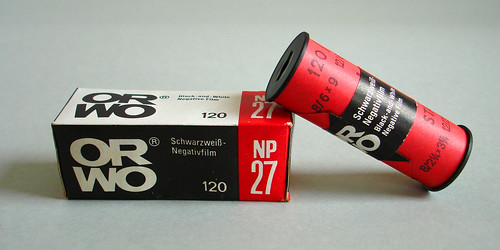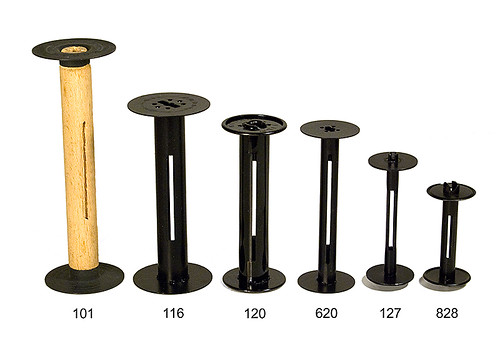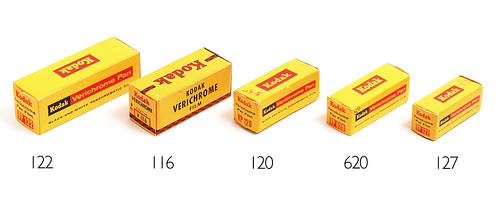Difference between revisions of "Rollfilm"
Tarn McDaddo (talk | contribs) (Added the Goodwin portion of the story, which was missing) |
|||
| (23 intermediate revisions by 7 users not shown) | |||
| Line 1: | Line 1: | ||
| − | + | {{glossary}} | |
| + | {|class=floatright | ||
| + | | | ||
| + | {{Flickr image | ||
| + | | image_source=http://www.flickr.com/photos/50678983@N00/423087604/in/pool-camerawiki | ||
| + | | image=http://farm1.static.flickr.com/187/423087604_4012f1d58a.jpg | ||
| + | | image_align=center | ||
| + | | image_text= 120 roll film and carton - once called "cartridge" film,<br>because the film roll somewhat resembled a shotgun cartridge | ||
| + | |image_by=Dries van den Elzen | ||
| + | |image_rights=wp | ||
| + | }} | ||
| + | |- | ||
| + | | | ||
| + | {{Flickr_image | ||
| + | |image_source= http://www.flickr.com/photos/30882099@N04/6056656012/in/pool-camerawiki | ||
| + | |image= http://farm7.static.flickr.com/6191/6056656012_40ea64374b.jpg | ||
| + | |image_align= center | ||
| + | |image_text= Spools from [[Film sizes and designations|various rollfilm sizes]] | ||
| + | |image_by= Joseph Greco | ||
| + | |image_rights= wp | ||
| + | }} | ||
| + | {{Flickr_image | ||
| + | |image_source= http://www.flickr.com/photos/48991633@N06/51281494862/in/pool-camerawiki/ | ||
| + | |image= http://farm3.staticflickr.com/65535/51281494862_1545c57b3a_d.jpg | ||
| + | |image_align= left | ||
| + | |image_text= Comparison of film boxes for 122, 116, 120, 620, 127 roll films. | ||
| + | |image_by= Tarn McDaddo | ||
| + | |image_rights= wp | ||
| + | }} | ||
| + | |} | ||
| + | '''Roll film''' refers to a method of film loading where the bare [[film]] is wound up on an open spool, but protected by an opaque paper backing. The roll is advanced through the camera in one direction only, leaving the exposed film wrapped up on the take-up spool inside the tail of the backing paper. This allows the roll to be removed in daylight. The (now empty) supply spool is then moved into the take-up compartment, ready to serve as the take-up spool for the next roll. | ||
| + | |||
| + | By the mid 20th century, photographers came to use the term '''rollfilm''' to differentiate paper-backed film rolls from [[Plate sizes|sheet film]], or [[35mm film|135 cassettes]]. | ||
| − | + | The opaque backing paper is typically printed with a series of frame numbers, visible through the [[red window]] peepsight on the camera back; this allows the photographer to advance the roll by the proper amount to avoid overlapping frames. | |
| − | + | Roll film has been available in many different [[Film_sizes_and_designations|standardized sizes]] over the years. The most popular roll film format, [[120 film|No. 120]], was introduced with Kodak's Brownie No. 2 in 1901 (although the number designation came later). Other popular rollfilm formats were [[116 film]], [[620 film|620]] and [[127 film|127]]. Around 1950 the early [[Polaroid|Polaroid Land Camera]]s used a special kind of rollfilm. Two rolls had to be loaded, one negative and one roll of paper receiving sheet for the positive print. | |
| + | The name "roll film" is almost synonymous with "medium format" today, but paper-backed film on spools is equally applicable to different sizes. Kodak produced 828 (35mm wide) and 127 (46mm), both of which occupied the market role of small format film together with 35mm, and smaller films existed; several companies made paper-backed roll-film in subminiature sizes, such as for the [[Hit]]. On the other hand, in the early days of roll-film, Kodak also produced large format roll film, such as 122 (3 1/4" x 5 1/2"), 123 (4x5") 115 (''7x5"''), all of which were in production for quite a few years before fading into obscurity in the mid-20th century. | ||
| + | |||
| + | ==History== | ||
| + | |||
| + | Perhaps the earliest rollfilm device was patented in 1854 by J. B. Spencer and A. J. Melhuish. It used "sheets of [[William Henry Fox Talbot|calotype]] paper gummed together and wound on rollers" [Coe]. In 1875 L. Warnecke got a patent on his "roller slide" for a more successful rollfilm variant, a paper roll with light sensitive dry collodion surface for 100 exposures. The rollholder was made well, but the film material was not. | ||
| + | |||
| + | In 1884 [[William H. Walker]] and [[George Eastman]] developed a rollholder attachable to standard plate cameras. Initially, the holder used a roll of paper coated in the light sensitive material. This suffered from the appearance of the grain of the paper. In 1885 they could present a new improved paper negative film which was called the "American Film", or "stripping film". The light sensitive layer of that film was made of gelatine. After development the film was soaked with warm water so that the gelatine layer could be stripped from the paper backing and transferred onto glass plates or another transparent base. That way the gelatine layer became a transparent negative. Thus the print quality could be improved. Stripping film was patented by George Eastman, as [http://www.google.com/patents?id=5KFEAAAAEBAJ US Patent 306594] issued Oct 14, 1884 and [http://www.google.com/patents?id=AHhEAAAAEBAJ&dq=306470&num=20 308017], Nov 1884. | ||
| + | |||
| + | Stripping film together with a Walker-Eastman rollholder was used for the [[Eastman Detective Camera]] developed by Eastman and F. M. Cossitt in 1886. A small number of these complicated cameras were made until 1888. The [[Kodak No. 1|Kodak Camera]] of 1888 was the most successful camera for "American Film", despite of the inconvenience that the whole camera had to be sent to the factory in Rochester when the film was exposed. There the film was developed, prints were made, and the camera was reloaded with a new 100 exposure film roll. The success of this camera was the base on which rollfilm [[box camera]]s stayed popular until the 1950s. | ||
| + | |||
| + | In 1887 the Reverend Hannibal Goodwin of Newark, New Jersey filed a patent for the production of photosensitive emulsion placed on a rolled celluloid base. Goodwin did not produce film under his patent at the time. In 1889 Eastman engaged Henry M. Reichenbach to find a transparent substitute for the paper base of the rollfilm. Reichenbach's solution to the problem was remarkably similar to Goodwin's solution two years earlier: Reichenbach created a celluloid (cellulose nitrate) of which flexible transparent foils could be made. The Eastman company began manufacturing film with a celluloid base in 1890. | ||
| + | |||
| + | In 1891 a daylight loading version of roll film was offered by [[Kodak]], the roll enclosed in a carton, with paper ends to have the film wrapped light-tight when loading or unloading. Meanwhile, Reverend Goodwin had retired from his clergy position and intended to begin manufacturing film under his own original patent. Goodwin contested the Eastman patent, a process that lasted until 1898, at which time Goodwin's patent was finally fully awarded. | ||
| + | |||
| + | Goodwin started the Goodwin Film and Camera Company, and began seeking financial backing to start production after his patent was finalized. However, on December 31, 1900, before he had secured the finances needed to start full production, he was killed in a streetcar collision. His widow sold all of the company assets, including the patent rights, to the recently merged E. Anthony & Co. and Scovill Manufacturing Co, which was soon to become known as [[Ansco]]. Ansco began producing film under the Goodwin patent, and then sued Eastman Kodak for patent infringement. The lawsuit was finally settled in Ansco's favor in 1914; however, by that time Kodak's dominance in the film production market had already been long established. | ||
| + | |||
| + | The modern paper backed roll film was developed by Samuel N. Turner for the [[Boston Camera Manufacturing Company]]<ref>Eder, J. M., ''History of Photography'', 3rd ed., 1905, English translation by Edward Epstein, Columbia University Press, 1945</ref>. Turner had obtained a patent for this film - including the [[red window]], applied for in 1892 and granted in 1895<ref>[http://www.google.com/patents?id=O9VpAAAAEBAJ&jtp=1#PPA1,M1 US Patent 539,713, Photographic Film Roll], S N Turner, 21 May 1895. Turner's drawings show, and the text describes, the film spooled the opposite way to the later convention.</ref>. It was introduced with that company's [[No. 2 Bulls-Eye]] box camera which was the first that had a [[red window]] as exposure counting facility for such film. [[Kodak]] bought the company so as not to be obliged to pay a license fee for the red window. The Turner patent was the subject of a legal dispute, where Eastman Kodak sued [[Ansco|Anthony & Scovill]] in 1905; the action was dismissed<ref>Eastman Kodak Co. v. Anthony & Scovill Co., Circuit Court, Southern District, New York, 30 June 1905</ref>. | ||
| + | |||
| + | |||
| + | {{Flickr image | ||
| + | | image_source=http://www.flickr.com/photos/uwe_kulick/4218335305/in/pool-camerawiki | ||
| + | | image=http://farm3.static.flickr.com/2732/4218335305_688ff57417.jpg | ||
| + | | image_align=left | ||
| + | | image_text=Other American [[folding|folders]] for rollfilm types<br/>[[120 film|120]], 122/125, [[620 film|620]]/120, [[116 film|116]], and [[127 film|127]] [[autographic]] | ||
| + | |image_by=Uwe Kulick | ||
| + | |image_rights=wp | ||
| + | }} | ||
{{Flickr image | {{Flickr image | ||
| − | | image_source=http://www.flickr.com/photos/ | + | | image_source=http://www.flickr.com/photos/bstrong/151206332/in/pool-camerawiki |
| − | | image=http://farm1.static.flickr.com/ | + | | image=http://farm1.static.flickr.com/49/151206332_a5d0e65c17_m.jpg |
| image_align=left | | image_align=left | ||
| − | | image_text= | + | | image_text=Influential US rollfilm camera design:<br />[[Frank A. Brownell|Frank Brownell]]'s [[Folding Pocket Kodak]] of 1897 |
| − | }}{{ | + | |image_by=Bill Strong |
| + | |image_rights=nc | ||
| + | }} | ||
| + | |||
| + | |||
| + | |||
| + | {{brl}} | ||
| + | ==Notes== | ||
| + | <references /> | ||
==Sources== | ==Sources== | ||
| + | <!-- a bit of a work-in-progress here and above --> | ||
* Coe, Brian: ''The Birth Of Photography'', 1976 | * Coe, Brian: ''The Birth Of Photography'', 1976 | ||
| + | * [http://www.google.com/patents?id=TZtrAAAAEBAJ Eastman Dry Plate Roll Holder patent 414735], Thomas Taylor | ||
| + | * [http://www.google.com/patents?id=di9cAAAAEBAJ&dq=461308 Blair Rollholder patent 461308] | ||
| + | * [http://www.google.com/patents?id=O9VpAAAAEBAJ&jtp=1#PPA1,M1 US Patent 539,713, Photographic Film Roll], S N Turner, 21 May 1895 | ||
| + | * [http://historiccamera.com/cgi-bin/librarium2/pm.cgi?action=app_display&app=datasheet&app_id=1405&_camco Blair Camera Company history] at [http://historiccamera.com/ Historic Camera] | ||
| − | + | [[Category: Film]] | |
Latest revision as of 04:07, 2 January 2022
| ||||
|
Roll film refers to a method of film loading where the bare film is wound up on an open spool, but protected by an opaque paper backing. The roll is advanced through the camera in one direction only, leaving the exposed film wrapped up on the take-up spool inside the tail of the backing paper. This allows the roll to be removed in daylight. The (now empty) supply spool is then moved into the take-up compartment, ready to serve as the take-up spool for the next roll.
By the mid 20th century, photographers came to use the term rollfilm to differentiate paper-backed film rolls from sheet film, or 135 cassettes.
The opaque backing paper is typically printed with a series of frame numbers, visible through the red window peepsight on the camera back; this allows the photographer to advance the roll by the proper amount to avoid overlapping frames.
Roll film has been available in many different standardized sizes over the years. The most popular roll film format, No. 120, was introduced with Kodak's Brownie No. 2 in 1901 (although the number designation came later). Other popular rollfilm formats were 116 film, 620 and 127. Around 1950 the early Polaroid Land Cameras used a special kind of rollfilm. Two rolls had to be loaded, one negative and one roll of paper receiving sheet for the positive print.
The name "roll film" is almost synonymous with "medium format" today, but paper-backed film on spools is equally applicable to different sizes. Kodak produced 828 (35mm wide) and 127 (46mm), both of which occupied the market role of small format film together with 35mm, and smaller films existed; several companies made paper-backed roll-film in subminiature sizes, such as for the Hit. On the other hand, in the early days of roll-film, Kodak also produced large format roll film, such as 122 (3 1/4" x 5 1/2"), 123 (4x5") 115 (7x5"), all of which were in production for quite a few years before fading into obscurity in the mid-20th century.
History
Perhaps the earliest rollfilm device was patented in 1854 by J. B. Spencer and A. J. Melhuish. It used "sheets of calotype paper gummed together and wound on rollers" [Coe]. In 1875 L. Warnecke got a patent on his "roller slide" for a more successful rollfilm variant, a paper roll with light sensitive dry collodion surface for 100 exposures. The rollholder was made well, but the film material was not.
In 1884 William H. Walker and George Eastman developed a rollholder attachable to standard plate cameras. Initially, the holder used a roll of paper coated in the light sensitive material. This suffered from the appearance of the grain of the paper. In 1885 they could present a new improved paper negative film which was called the "American Film", or "stripping film". The light sensitive layer of that film was made of gelatine. After development the film was soaked with warm water so that the gelatine layer could be stripped from the paper backing and transferred onto glass plates or another transparent base. That way the gelatine layer became a transparent negative. Thus the print quality could be improved. Stripping film was patented by George Eastman, as US Patent 306594 issued Oct 14, 1884 and 308017, Nov 1884.
Stripping film together with a Walker-Eastman rollholder was used for the Eastman Detective Camera developed by Eastman and F. M. Cossitt in 1886. A small number of these complicated cameras were made until 1888. The Kodak Camera of 1888 was the most successful camera for "American Film", despite of the inconvenience that the whole camera had to be sent to the factory in Rochester when the film was exposed. There the film was developed, prints were made, and the camera was reloaded with a new 100 exposure film roll. The success of this camera was the base on which rollfilm box cameras stayed popular until the 1950s.
In 1887 the Reverend Hannibal Goodwin of Newark, New Jersey filed a patent for the production of photosensitive emulsion placed on a rolled celluloid base. Goodwin did not produce film under his patent at the time. In 1889 Eastman engaged Henry M. Reichenbach to find a transparent substitute for the paper base of the rollfilm. Reichenbach's solution to the problem was remarkably similar to Goodwin's solution two years earlier: Reichenbach created a celluloid (cellulose nitrate) of which flexible transparent foils could be made. The Eastman company began manufacturing film with a celluloid base in 1890.
In 1891 a daylight loading version of roll film was offered by Kodak, the roll enclosed in a carton, with paper ends to have the film wrapped light-tight when loading or unloading. Meanwhile, Reverend Goodwin had retired from his clergy position and intended to begin manufacturing film under his own original patent. Goodwin contested the Eastman patent, a process that lasted until 1898, at which time Goodwin's patent was finally fully awarded.
Goodwin started the Goodwin Film and Camera Company, and began seeking financial backing to start production after his patent was finalized. However, on December 31, 1900, before he had secured the finances needed to start full production, he was killed in a streetcar collision. His widow sold all of the company assets, including the patent rights, to the recently merged E. Anthony & Co. and Scovill Manufacturing Co, which was soon to become known as Ansco. Ansco began producing film under the Goodwin patent, and then sued Eastman Kodak for patent infringement. The lawsuit was finally settled in Ansco's favor in 1914; however, by that time Kodak's dominance in the film production market had already been long established.
The modern paper backed roll film was developed by Samuel N. Turner for the Boston Camera Manufacturing Company[1]. Turner had obtained a patent for this film - including the red window, applied for in 1892 and granted in 1895[2]. It was introduced with that company's No. 2 Bulls-Eye box camera which was the first that had a red window as exposure counting facility for such film. Kodak bought the company so as not to be obliged to pay a license fee for the red window. The Turner patent was the subject of a legal dispute, where Eastman Kodak sued Anthony & Scovill in 1905; the action was dismissed[3].
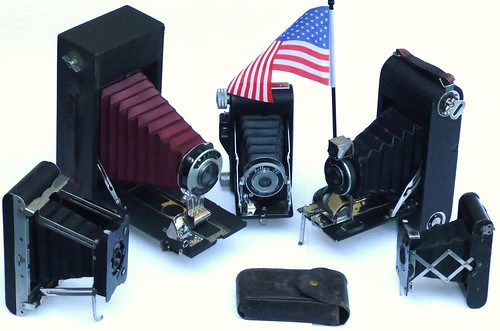
|
| Other American folders for rollfilm types 120, 122/125, 620/120, 116, and 127 autographic image by Uwe Kulick (Image rights) |
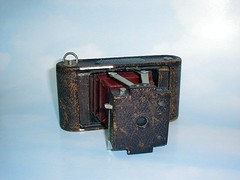
|
| Influential US rollfilm camera design: Frank Brownell's Folding Pocket Kodak of 1897 image by Bill Strong (Image rights) |
Notes
- ↑ Eder, J. M., History of Photography, 3rd ed., 1905, English translation by Edward Epstein, Columbia University Press, 1945
- ↑ US Patent 539,713, Photographic Film Roll, S N Turner, 21 May 1895. Turner's drawings show, and the text describes, the film spooled the opposite way to the later convention.
- ↑ Eastman Kodak Co. v. Anthony & Scovill Co., Circuit Court, Southern District, New York, 30 June 1905
Sources
- Coe, Brian: The Birth Of Photography, 1976
- Eastman Dry Plate Roll Holder patent 414735, Thomas Taylor
- Blair Rollholder patent 461308
- US Patent 539,713, Photographic Film Roll, S N Turner, 21 May 1895
- Blair Camera Company history at Historic Camera
